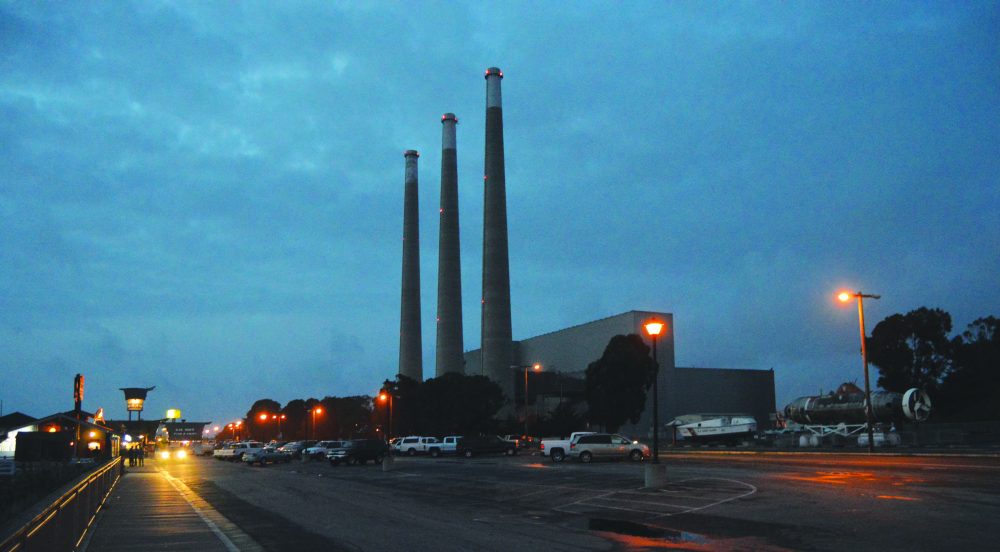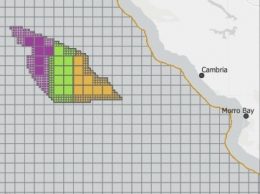Morro Bay stacks could go up in smoke under new agreement with battery project developer
IN THIS ARTICLE
- Central Coast Topic
- Marissa Nall Author
By Marissa Nall Thursday, June 10th, 2021

The city of Morro Bay and Vistra Energy have reached an agreement that smoothes out several roadblocks that stood in the way of Vistra’s proposal to build the world’s largest battery storage facility on the Central Coast.
Vistra and city staff members reached a memorandum of understanding that was approved by the Morro Bay City Council in a 5-0 vote on June 9. The MOU removes thorny issues of eminent domain rights around the former Duke Energy power plant where the project is proposed, and could call for the removal of a prominent feature of the Morro Bay landscape: the three smokestacks that sit opposite the iconic Morro Rock.
“It paves the way for the actual development of the parcel and the realization of some real benefit for the city of Morro Bay,” Morro Bay Mayor John Headding told the Business Times before the council vote.
Vistra’s proposal for a 600-megawatt storage facility is under review with the city’s Planning Division before it heads to the City Council for approval. It would include the construction of three new buildings on 22 acres at the retired natural gas power plant. Construction would begin in 2022, and the development is projected to come online by the end of 2024.
“Should the full City Council approve the MOU, Vistra looks forward to continuing the work to build the battery project and the coming discussion with the city and residents of Morro Bay about the future of the rest of the plant site,” Claudia Morrow, senior vice president of corporate development at Vistra, said in a news release issued before the final MOU approval.
The MOU between the Texas-based energy developer and the city does not approve the project, but it does settle concerns about the city’s right to take control of the property.
An existing stipulation that the city has the right to purchase the former power plant has discouraged development at the site, Headding said. It gives the city an opportunity to purchase the land for $1 in 2033, if the stacks haven’t been demolished by that time, which has deterred companies from investing in new projects there.
The MOU removes that rule as a barrier for Vistra’s $500 million proposal, Headding said, as well as eliminating potentially steep costs for the city to demolish the stacks and on its own.
Instead, Vistra will have until the end of 2027 to complete demolition of the former generation building and stacks, unless the city decides by the end of 2022 to preserve them.
In the meantime, Morro Bay plans to ask city residents whether they want to maintain the stacks as a landmark or have them torn down. They have been a recognizable part of the landscape since 1955 when they were built by Pacific Gas & Electric Co., and they were idled in 2014.
The MOU gives the city an opportunity to conduct public forums on whether or not residents want to keep the stacks up, Headding said — and pay to preserve them.
“If you walked down the street and asked ‘should we keep the stacks, or should we tear them down?’ it might be 50/50,” he said. “To maintain something that may be iconic to some people could be a tremendous heavy economic burden to the city in the future.”
The MOU also resolves a legal dispute between Vistra and the city, which was attempting to use eminent domain at the property to acquire easements for wastewater injection wells to support its planned water reclamation facility. The city sought to purchase the easements for around $200,000, Headding said, while Vistra valued them as high as $6 million.
Lastly, the MOU sets up negotiations between Vistra and the city on roadway and infrastructure improvements related to the project and the potential acquisition of a park on a portion of the property.
The battery proposal occupies just 22 acres of the 107-acre property, Headding said, “which means that the large portion of the remainder property could be developed by Vistra … This opens up a robust process for engaging the community and dialogue about the rest of the property and what can be done there.”
If it gains approval from the city, Vistra’s proposal would also need to go before the California Coastal Commission, as well as meet state regulatory requirements under the California Environmental Quality Act.
Should it get the green light, it would complement plans for offshore wind energy generation that were authorized by the U.S. Navy and Department of the Interior in May.
“This produces great synergies with regard to the potential battery project storage and wind energy off the coast of Morro Bay,” Headding said.
That project is expected to move quickly in response to the loss of jobs and greenhouse-gas-free energy generation with the closure of Diablo Canyon Nuclear Power Plant, he said.










